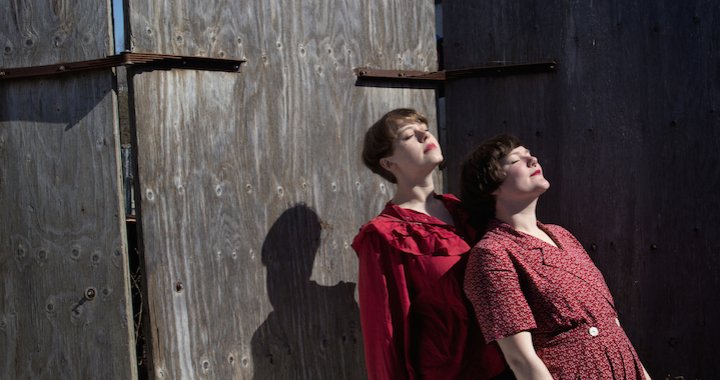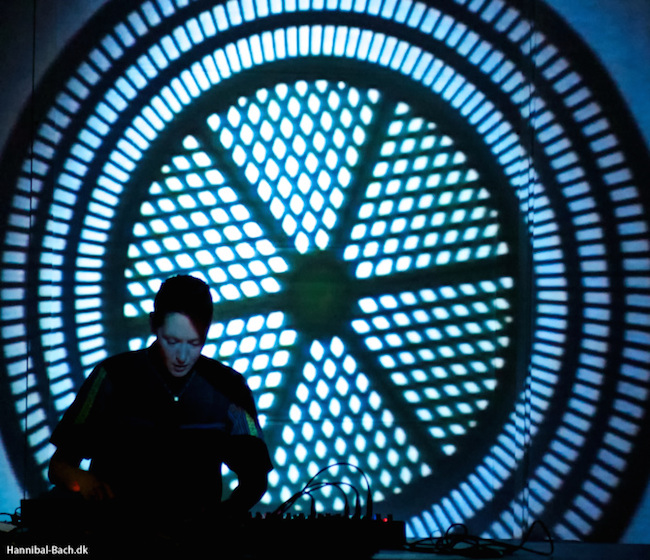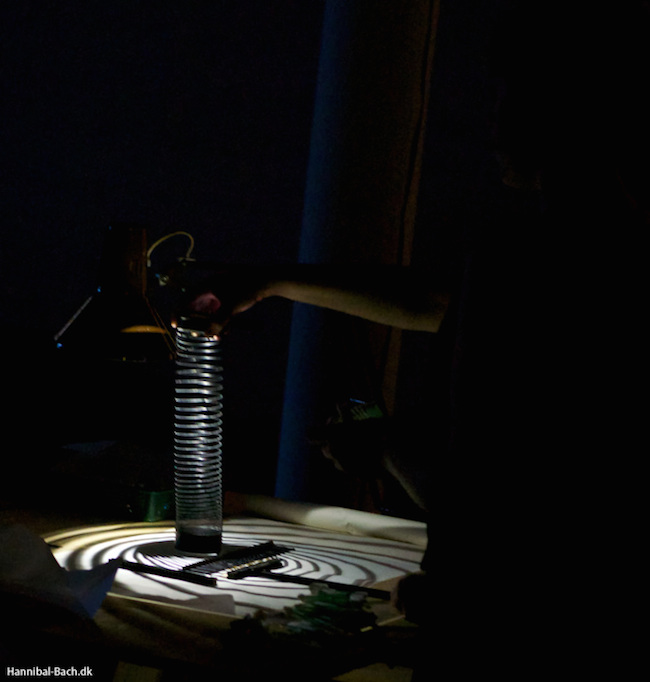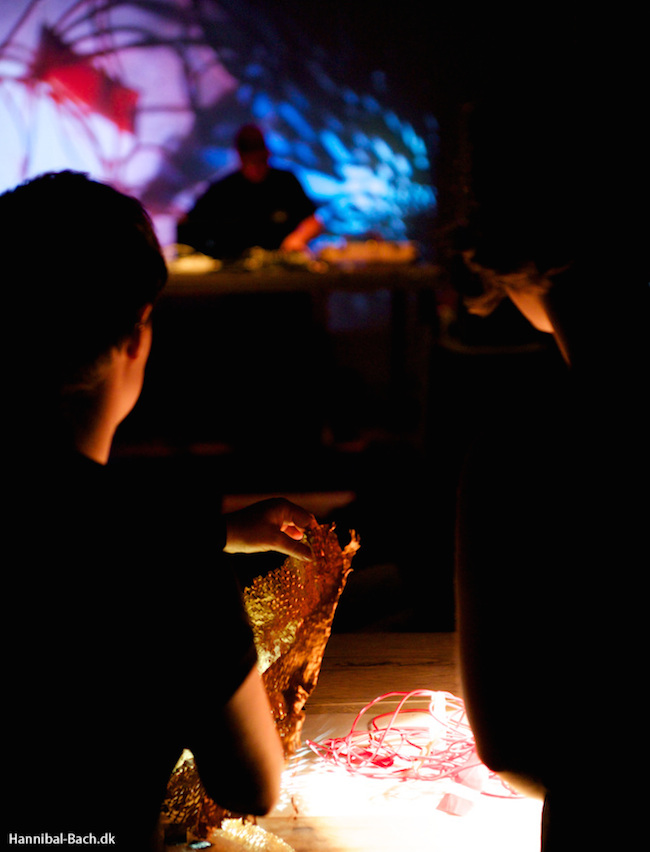
Magical Realism
An interview with MANUALS – VJ duo: Freya Sif Hestnes and My Lambertsen from Copenhagen
Ann Mirjam Vaikla
19/05/2015
“There's a contemporary tendency and need for authenticity these days, and MANUALS has some of that it its form of hand held, the process live being uncovered and visible to the audience - and still it seems magical. The materials are still being staged by light and movement, but it's still just a salad bowl or a part of bicycle.”
First of all, what is MANUALS?
We call it “live-performed manual visuals”. Maybe that’s the best description. It’s a VJ duo making live visuals out of objects and light and transparency and different materials and colors. It is simultaneously being filmed and projected into the same space, directly from the camera. The camera is underneath our light table, so it films the actions we are doing above: movements, shadows, colors…
Who is behind the artistic duo called MANUALS?
I (Freya) am a scenographer and visual artist; I also work quite a lot with photography. My is a musician and performing arts designer. She has also a good base of technical knowledge.

Technical set up
Do you bring your own equipment?
We have our own gear. We use a transparent light table. The table has a hole cut out in the middle of it, which is then covered with a transparent surface. Beneath the transparent surface there is a camera that films everything that happens within the frame. We place objects and lights on top of the transparent surface to create illusions. We also bring the objects. We spend a lot of time experimenting and getting to know the materiality of the objects. At the same time, the objects are really casual and become trashy as they are transformed through the meeting point of their physicality and light situation.
Tell me about the different venues in which you have performed. How does each specific venue affect your actions?
We generally work in very varied situations, with different artists and venues. Recently we’ve been working a lot with electronic music and DJs. This is really nice as we are actually allowed to create a world which has something to tell itself. It is very hard when we are expected to be just a backdrop – we take up a lot of space and attention.

MANUALS is more than just a backdrop.
Yes, because if it was just a backdrop, then it could fit into anything; but we have had to say no to some jobs that we really wanted to do. It is important for us that the session is about the featured artist, but at the same time, it is kind of impossible to stick us away in a corner because we do attract a lot of attention. People see our performative actions, including the materials that we use. For example, you can see that I’m standing here with a big bike wheel and a flashlight, and there is something very abstract happening on the screen – connecting these two points is like a performance in itself. That's why we prefer to jam with artists who can get into a dialogue with us.
Tell me about the preparatory stage before different venues – how much do you actually prepare beforehand?
It really depends. Sometimes we spend a lot of time, for example, finding new materials, experimenting with different things and so on – if we feel that we need to. It’s also about where we are in the project – if we want to expand our vocabulary, or do we want to dig further into what we already have. On occasion we don’t have very much time, so then we look at things quickly, since we know what they can do, and we make a set-list. The last time we performed was actually a pretty big experience for us as it was the very first time that we decided to improvise everything. We were on for four hours at a huge party, "Not All Cats Are Grey In the Dark" (the closing party for PB43, 43Farben, Copenhagen). We were scheduled from one o’clock in the morning until five am. We were eager to improvise throughout the whole period, so we just brought all of the materials that we had and tried to arrange them somehow so that we would be ready for anything. The place was packed with our stuff! But it is quite an unpredictable process because some things, such as a big object, can be interesting for a few minutes, whereas something really small, almost invisible, can end up being interesting for a whole 15 minutes. You really never know.

MANUALS at Phono Festival. Artist - Karen Gwyer. Photo: Hans Kristian Hannibal-Bach
Do you listen to the music before you begin creating visuals to it?
Yes. When we meet, we always have new elements that we’ve found and want to try out. Then we have a jam session in which we don't think so much about the music, but rather play around with the possibilities that the objects afford. In this process, it always takes a while to get into the material, to incorporate and to understand the possibilities of it. Also, combining it with other materials can take a while because it is hard to predict what will happen with the light. The light changes everything.
During the preparatory stage, do you also try to pinpoint a story/image/script that you could show? Are there preset themes?
Maybe sometimes… Last fall, at the Phono Festival in Odense, there were four different artists for whom we were to create visuals. We listened to their music beforehand and tried to match it with different sensations. For example, we wanted one of them to be very graphical, but with another one we wanted to play more with the transparency effect – creating a sensation of something strangely intimate and diffused. For that one we used an elastic surface that we lighted from beneath so that the whole atmosphere would become strange and vulgar.
It is ever a still image?
It always has some kind of movement. Sometimes it is just about pulsating with a light source. The first time we did it, it was really choreographed. We knew exactly what to do and when, how the changes between different elements should be, what objects to use. I think that was a good way to start as it was difficult to make it work in the beginning. It really took a while to build up a vocabulary.

MANUALS at Phono Festival. Artist - Karen Gwyer. Photo: Hans Kristian Hannibal-Bach
It makes me think that this playground that you have created for yourselves has a rather strong frame surrounding it, but you can always keep improving what happens inside of it.
There is always something new within it – always something new to discover! Which is really great because I think we are both the kind of people that don’t want to repeat themselves. It is very important for us to constantly renew it, to make it fun! We are really lucky in that it keeps expanding and there is always something new to try out.
How much does the location in which you will be performing mean to you?
The location is always crucial in the interaction between the audience and the artists. Apart from that, the projection is, of course, the direct link between the artistic output and the physical space because the projection is physically interacting with the space. The possibilities that we can find on location, that relate to the projection, are crucial. The structure of the space means everything in terms of how our visuals will be perceived. It is important how our visuals are presented at each space. Is the projection hidden behind the band? Is it hanging high over the audience, so that you can see every detail of what is going on, or is it mapped out in various specific areas? These issues are crucial in relation to what kind of expressions and methods we end up using.
Do you also see the screen on which your actions will be projected?
Yes, we see the screen. We have also talked about having a monitor on a tripod, but I really like the fact that we can see it and that we can see the artist as well. Another great thing is to project on the artist or on the musician because then we can, for example, put a spot-light on a person, play with the lights and shadows, and so on.
Our aim right now is to form a very tight collaboration with one specific band or group of dancers – we want to have some more time to practice together, so that we're able to respond to each other. We are very much interested in improvisation right now, and we find that our role is to somehow create the world in which the performance takes place. In the future, it would be interesting to experiment and see what happens when the world is already set, and then we see what we can develop from that.

MANUALS at Phono Festival. Artist - Karen Gwyer. Hans Kristian Hannibal-Bach
A technical question – how do you manage to keep your hands out of the frame?
We have a lot of technical support for that; it is kind of an important thing for us. Basically, we just push objects into the frame from the sides. You kind of learn how to get around and keep your hands out of the light. In the beginning it was really hard because we wanted to play with the elements, and you'd have this feeling of knowing exactly where you want a certain object to be, but you don’t want the shadow of your hand interfering! I guess it is just something we came to learn how to do with time – to work with the shadows.
Have you ever used text or some other clear signs/symbols in your visuals?
No text. But we’ve started to use some more figurative elements and landscapes; also graphical surfaces.
Do you talk with each other during the session?
Yes, we do, but not much. I think we are getting increasingly better at doing things and taking risks. It’s a lot about trust as well. I feel that, through working so much together, we really have reached a point in which I can, for example, go away for a little bit and I trust that she is in a good flow, or that now she needs a challenge, or that now I should take over.
Do you create all the images together, or do you do some individually?
Both, but we really do a lot together! This last time we played a game in which My had to find five objects for me that I had to use – despite the fact that they were crazy objects, it turned out great because we challenged each other! It is also good to have four hands because you can make a detail work better that way, or for example, one can move an object while the other one moves a light source. It takes a lot of focus and concentration to move things – it really is very much like puppetry!
How did MANUALS start up?
I think we are a very good team because we have different approaches, but pretty much the same interests. We met when we were 15 years old – we went to school together. I remember this one specific bonding moment. My was living in a huge, amazing old house with her family. The house used to function as a dairy manufacturing plant in the past. One day she showed me the attic that held a huge collection of old glass bottles in different colors. I remember that I was just blown away by all these colors and light and transparency… I think we had this mutual but unconscious interest in light, materiality and objects, and how they can transform and take on different shapes and characters. We didn’t start to work together until a few years ago, but that shared universe has always been there. In August 2012 we did our very first session together.

MANUALS at Phono Festival. Artist - Karen Gwyer. Photo: Hans Kristian Hannibal-Bach
What makes MANUALS stand out when compared to the VJ scene in Copenhagen?
Our performative action is special in that we create, arrange and modify the visual content live, on site. MANUALS' visual expression is filled with playfulness, humor and lo-fi aesthetics – we find most of our materials at the dump, at flea markets and in second-hand shops. It has a magical realism to it – the transformation of everyday objects into magical graphics and abstract illusions.